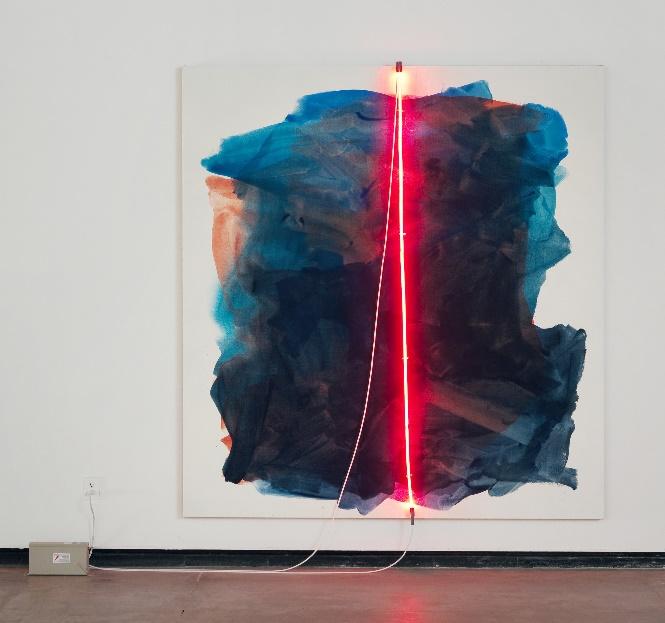Recently I have visited an exhibition “Mountains Mud Prisms Air” by a modern artist named Mary Weatherford at David Kordansky Gallery. This exhibition greatly impressed me since the painter in her art uses the unusual technique of combining canvas painting with neon vet which is a glowing line of various colors and lengths. Thus, the pictures become very vivid and contrasting, and the whole gallery has seemed like an abode of a shimmering light. The theme of a collection of artworks has been portrayal of nature, and all Weatherford’s works relate to this topic through a vivid portrayal of natural phenomena. Almost all of her works are presented in the form of chaotic lines of various colors. Due to the brightness and unusual nature of the chosen light effect, the artist masterfully creates a contrast between the main canvas of the painting and the neon line passing through it.
The painting that impressed me most is called “La noche” and it was created in 2014.

The painting “La noche” is a sound example of abstractionism; the work got its name from the Italian word ‘night’ and depicts the blackness and impenetrability of the darkness. It is a vertically oriented canvas with sharp, uneven contours. The paint is applied in large strokes, chaotically, as if without any purpose and meaning, covering the canvas with a thick layer. The painting “La noche” is pure emotions, without the slightest similarity with any geometric shapes. In it, Weatherford managed to release colour form the confinements of shape, portraying the limitless black and blue infinity, patched at its contours with orange and red colours.
In the painting, orange and red shades seem to break out from under layers of black and dark blue, and are slightly visible under the seemingly torn parts. The colours are lively, dynamic, and impressive in scale for every true connoisseur of painting (DeWitte et al., 2012). The oil paint put to the canvas with the movements of a spatula seems carelessly applied, but at the same time creates a sense of the integrity of the picture. The painting “La noche” seems to be a large fragment of an even larger field, as if extending beyond the painting. This impression is enhanced by the apparent incompleteness of the canvas, where dark strokes create a blurred and heterogeneous background, on which a bright glowing line appears.
The ray of light is represented by a neon strip running along the center of the picture as if dividing the picture into two parts. This creates the effect of the boundlessness of space; the artist wants to show that night is not an impenetrable darkness, but only a transient phenomenon of nature. The dividing light strip also emphasizes the difference between the night and the day that replaces it, which, as it were, remains outside the frame of the picture. As night gradually turns into day starting form the fringes of the horizon, bright colours are concentrated around the sides of the picture, and only a neon strip runs in the center of it adding to the contrast of the canvas. The light effects spellbound the viewer, making him or her gaze in awe at the colour change.
The painting “La noche” is a reflection of the conflict between the plot of the painting, limited by the size of the canvas, and the infinity of the whole, constantly reasserting itself, trying to go beyond the picture, to break its outer contour. Weatherford, thus, makes an attempt to force the viewer to look at the world around him or her in a different way. The artist is convinced that deep forms and colorful landscape objects are hidden in the combination of free lines and different colors. Bright colours seems to be breaking from under the darkness heralding the beginning of a new day, while the neon line in the center of the picture can be compared to a ray of sun penetrating dark clouds. The colour of neon light – red – is not random since the sunrise usually has red and orange colouring. The painting “La noche” can be compared with the works of Marco Rothko, who also used abstractionism as a basis for creating an artistic image. Both painters managed to find combinations of shades valuable in themselves, in their minimalism and purity, regardless of the meaning that the artists put into them.
The painting ‘La noche” with its depth and richness of colours offers the viewer to feel the maximum closeness to eternity. Either in weightlessness in the silence of outer space, or in the richness of night, the view feels immersed in the picture and surrounded by nature itself. This work calls on a person to see the unseen in the canvas and unravel the meaning of the meaningless.
The perception of the picture depends on the viewer’s personal imagination. In any case, the canvas is designed to generate a certain mood in a person. It seems to me that the painting is intended to embody the infinity of the night, and at the same time emphasize its temporary, transient nature, expanding the horizon of the painting beyond the canvas. The artist tried to express a complex pattern with the help of simple combinations in which the play of lines and color shades is clearly intertwined. In parallel and vertical lines, colorful sketches, color knurling, the author presents an attempt to unravel the phenomena of nature, which makes every viewer return to the picture again and again.
Work Cited
DeWitte, Debra J., Ralph M. Larmann, and M. Kathryn Shields. Gateways to art. New York, NY, 2012.